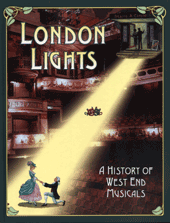Chronology
THE PRECISE ORIGINS of the modern musical are still open to some debate:
Alan Jay Lerner, one of the most distinguished historians of his own field,
considered that they could be traced back to street celebrations at the time
of the French Revolution, while there have always been those who reckon that
it began with Milton's masque Comus back in 1634 or else with John
Gay's The Beggar's Opera of 1727. What seems open to less argument
is that a fire on 14th Street in New York during the late summer of 1866
led to the largely accidental staging of The Black Crook, which
is now generally accepted as the first indoor non-operatic stage show to
integrate plot, song and dance. Not that it was ever meant to, and for those
of us who have always regarded the development of the modern musical as a
remarkably haphazard kind of miracle there is something deeply reassuring
in discovering that this was also the way it began.
Extract from Spread a Little Happiness - The first 100 years of
the British Musical by Sheridan Morley.
LONDON LIGHTS
It is believed this book will fill a gap in the history of London Musicals. Its main aim is to paint a broad canvas from the Victorian times to the late-20th century but concentrating unashamedly on the older rather than the newer. In this manner it hopes to rekindle many long- forgotten memories for "silvertops" while opening up a new vista for younger readers.
Many contemporary volumes have been published down the years but none has previously attempted to pull all the strings together. In addition it is hoped that the Appendices, which have taken more than four years to compile, will prove a valuable source of reference for years to come.
When the book was first suggested by Richard Stevens of Angel Radio on the Isle of Wight, it was intended to be a compilation of the articles published in This England magazine under the title of "London Lights". This colourful series ran from Summer 2000 until Winter 2003 but research on this volume began long before it ended. Nobody, however, could possibly have imagined it would end up
listing more than 2,000 Musicals, 350 theatres, and the dates of more than 1,200 famous people — not to mention nearly 300 photographs and illustrations. Whilst the extensive Appendices do not claim to be comprehensive — nor can they ever be guaranteed 100% accurate — nothing like them has ever been attempted before. Anyone able to plug any of the gaps, however, is most welcome to contact the author.
All the chapters stand alone, but they are also inter-linked. Occasional repetition was therefore necessary to complete individual stories but the overall pattern is well established.
It has become fashionable in recent years to denigrate the past but that is to completely miss the point. Everything in history is a product of time and space, and relevant only when seen in context. Popular music never stands still and identical words of a love song today can mean something very different to what they meant 100 or even 50 years ago. Celebrity status is also nothing new but what has changed is that the media now creates them artificially whereas most of the stars in this book achieved fame through sheer wealth of talent. There was no short-cut to the top in those days!
Read on and enjoy the unfolding story of the London Musical. When it began it was very much subservient to the London Play, but after more than a century it has now finally taken over as the dominant partner in the West End. Long may it continue!
EDMUND WHITEHOUSE - This England Magazine
The London Shows - Chronology
The original opening date is the official frst night, not counting previews, unless otherwise stated. By and large revivals of shows are not included. In later years, unless show runs have been officially published I have assumed 8 shows per week, uncluding matinees. Where only short runs have been scheduled I have given the opening and closing dates only. Further information about the shows can be found by clicking on the show title where linked.
Original listing by Edmund Whitehouse of "This England" magazine